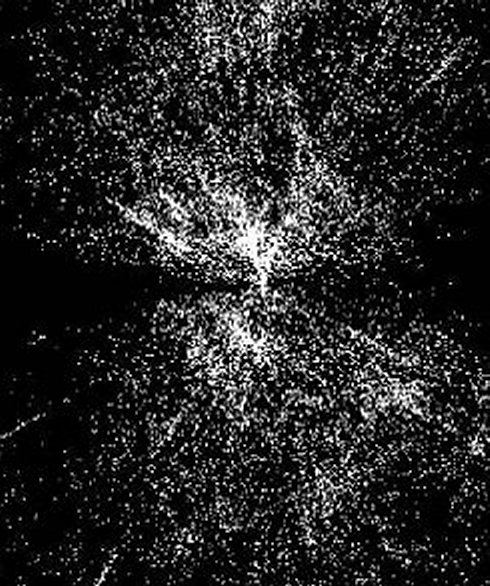The Stars and Sand
Is the Bible Divinely Inspired?
multitude, and as innumerable as the sand which
is by the sea shore, were fathered by one man..."
(Hebrews 11:12]
Have you ever had trouble "proving" to someone that the Bible is divinely inspired? Well, here's something that might help; it's really simple and yet mind-blowing at the same time.
When we talk about the universe, it's important to qualify the word "universe" as "known universe". I say that because the most dramatic discoveries have happened in just the past few decades; and only Elohim (the Creator) knows what other discoveries await us.
 In 1989, two astronomers discovered a "Great Wall" of galaxies1 spanning millions of light-years2. This "Great Wall" is estimated to be 500 million light years (3 quintillion miles) long, 200 million light years (1.2 quintillion miles) wide, and 15 million light years (90 quadrillion miles) thick3.
In 1989, two astronomers discovered a "Great Wall" of galaxies1 spanning millions of light-years2. This "Great Wall" is estimated to be 500 million light years (3 quintillion miles) long, 200 million light years (1.2 quintillion miles) wide, and 15 million light years (90 quadrillion miles) thick3.
The "Great Wall" consists of more than 15,000 galaxies, each with billions of stars. Based on detailed measurements of each galaxy's brightness, thus rendering an approximate number of stars they each contain, astronomers estimate that this "Great Wall" consists of 1500 trillion (1,500,000,000,000,000) solar systems!
The following year, astronomers discovered more than a dozen other evenly-distributed clumps of galaxies, suggesting a structure to the universe that is so regular and immense that it defied the then-existent theories of cosmic origins.
But here's the really neat part! A team led by an Australian astronomer calculated the number of stars in the known universe to be 70 sextillion3. Seventy sextillion is 70 followed by 21 zeros; so 70 sextillion3 is 70 followed by 21 zeros x 70 followed by 21 zeros x 70 followed by 21 zeros (or 343,000,000,000,000,000,000,000,000)! One scientist made the statement that this unfathomable number is "more than 10 times the grains of sand in every beach and desert on earth!"
Now consider this: In Genesis 22:17, God told Abraham "...in blessing I will bless you, and in multiplying I will multiply your seed as the stars of the heavens, and as the sand which is on the seashore..."
Think about that for a moment . . . Don't rush over the text . . . Let it sink in . . . God's Word actually compares the number of stars in the heavens to the grains of sand on the seashore...
Prior to the invention of the telescope in the 1600s, stargazers could only count a few hundred stars. Surely, comparing the number of stars in the heavens to the sand on the seashore would be an absurd conjecture for a mere human author to make 6,000 years ago. And even after the invention of the telescope, for the next 3 centuries mankind only knew of several billion stars — still not enough to compare the stars in the heavens to the sand on the seashore. Until 1989, that is...
Who but the Elohim Himself knew that relating the stars in the heavens to the sand on the seashore was a perfectly logical comparison? And who but the Author Himself would deign to expose that analysis to the presumptuousness and ridicule of thousands of "enlightened" humans, when all human logic demanded its exclusion?
Psalm 147:4
Who can fully comprehend the Elohim who counts the stars and knows all of them by name? As Christian author John Piper rightly noted in "The Pleasures of God": "What is this universe but the lavish demonstration of the incredible, incomparable, unimaginable exuberance and wisdom and power and greatness of God! What a God He must be!" Amen, John!
Cause for pause . . . If Scripture written 6,000 years ago is proved today to be so scientifically accurate, who's to say which other of the Bible's claims and revelations are true...?
By the way, here's another tidbit you might find interesting: Read Isaiah 40:22 where it talks about the Elohim sitting "above the circle of the earth..." What?! The circle of the earth? Why in the world would the Prophet Isaiah write about a round earth when everyone knew it was flat? Oh, wait! Isaiah didn't say it. God did! Hmmmmm....
1 Astronomers Geller and Huchra discovered the "Great Wall" on the first three sections of the CfA (Center for Astrophysics) redshift survey, which covered the region from 8 to 16 hours of right ascension and from 26.5 to 42.5 degrees of (north) declination. Although the Leo and Hercules Clusters lie slightly south of this region, the authors make it clear that the same structure extends south of the survey boundaries. The wall of galaxies is skewed to our line of sight, with a mean redshift distance that varies from Z=0.023 (~350 million light years) in Leo to Z=0.033 (~500 million light years) in Hercules.
2 A light year is the distance light travels in a year. Calculation: light traveling at 186,000 miles/second x 60 seconds/minut x 60 minutes/hour x 24 hours/day x 363 days/year = 5,865,696,000,000 (5.87 billion) miles/year.
3 When discussing the galaxies and solar systems in the known universe, the terms "millions", "billions", and even "trillions" are too small. Here's an explanation of all the "illion" names: million (6 zeros), billion (9 zeros), trillion (12 zeros), quadrillion (15 zeros), quintillion (18 zeros), sextillion (21 zeros), septillion (24 zeros), octillion (27 zeros), novillion (30 zeros), and decillion (33 zeros). And building on "decillion" are: undecillion (36 zeros), duodecillion (39 zeros), tredecillion (42 zeros), quattuordecillion (45 zeros), quindecillion (48 zeros), sexdecillion (51 zeros), septendecillion (54 zeros), octodecillion (57 zeros), and novemdecillion (60 zeros). And rounding out the "illions" are vigintillion (63 zeros) and centillion (303 zeros). "Zillion", "gazillian", and "bijillion" are made-up terms.
Kosmic Plenum MadSci Network: Astronomy American Astronomical Society Harvard-Smithsonian Center for Astrophysics

